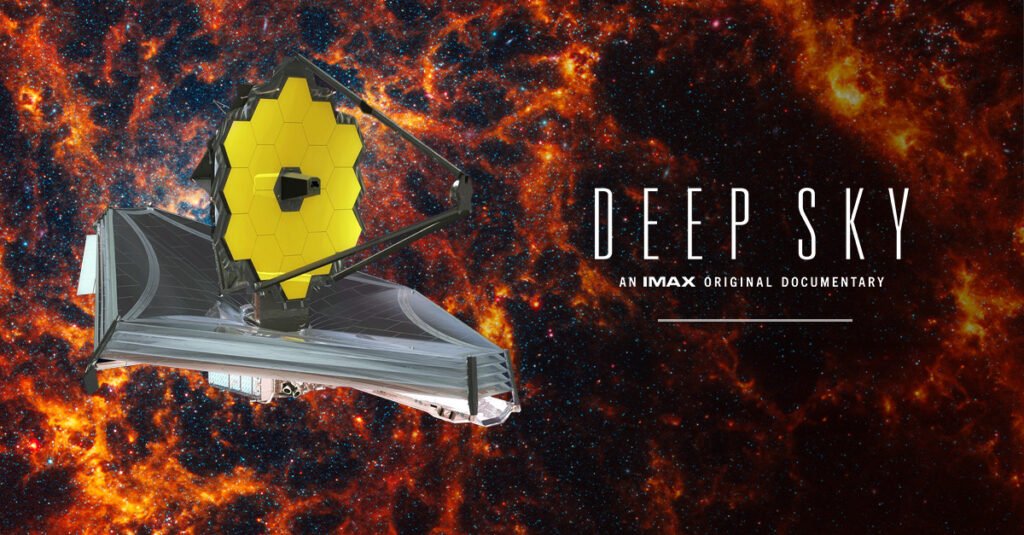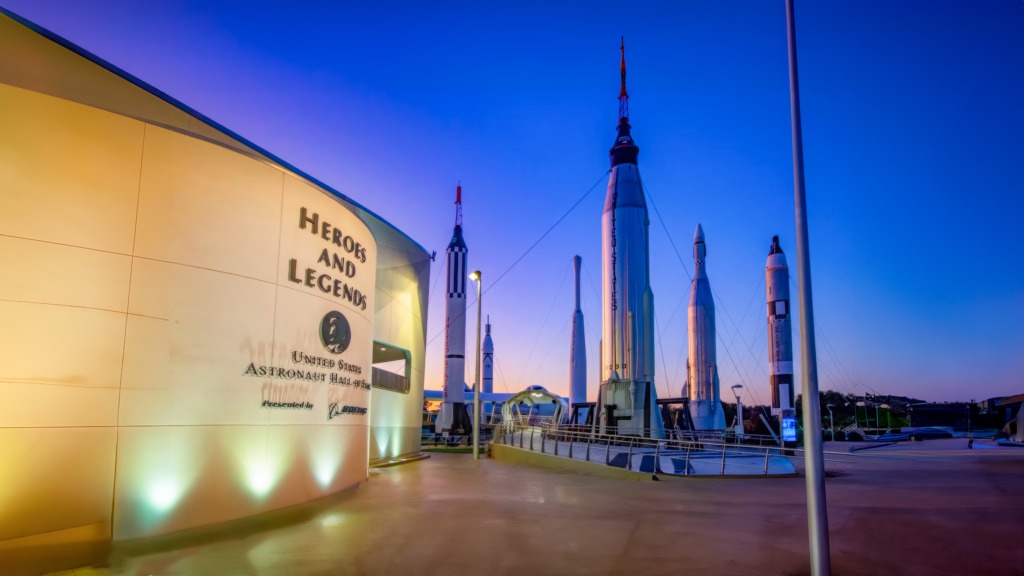A lone golden mirror floats in a silent sea of darkness. In the opening moments of Deep Sky, the James Webb Space Telescope appears as a tiny speck against a vast backdrop of stars. There is no Earth in sight, no Sun—only the solitude of space. This striking IMAX image drives home the sheer scale of the cosmos and the boldness of sending a telescope a million miles from home. It’s a quiet scene that captures the awe and isolation of a machine built to explore ancient starlight. Immediately, the film invites viewers to reflect on our place in that immense expanse.
Deep Sky, a new 40-minute IMAX documentary directed by Oscar-nominated filmmaker Nathaniel Kahn and narrated by actress Michelle Williams, chronicles the high-stakes journey of the James Webb Space Telescope (JWST). The film follows the telescope’s conception, its nail-biting launch in 2021, and its awe-inspiring first images of the universe. In doing so, Deep Sky offers more than a technical recap; it provides an intimate look at humanity’s quest to understand cosmic origins. The documentary is a collaboration with NASA (along with the European and Canadian space agencies) and continues a decades-long tradition of bringing space to giant screens. With a calm storytelling style and grand visuals, it transforms complex science into an experience The Atlantic’s readers would appreciate: intelligent yet accessible, wondrous but grounded.
A Telescope at the Edge of Space
The James Webb Space Telescope itself is a marvel of human engineering and ambition. NASA built it in partnership with the European and Canadian Space Agencies, assembling a gold-plated mirror over six meters across—large enough that it had to fold like origami to fit into a rocket. After decades of planning and innovation, and a budget of roughly $10 billion, JWST finally launched on December 25, 2021. A European Ariane 5 rocket carried it into the sky, a symbolic gift to science on that Christmas morning. Unlike the Hubble Space Telescope, which orbits just above Earth, Webb was sent far beyond the Moon to a spot called Lagrange Point 2, about one million miles away. This distance offers a stable vantage and deep darkness for observing the cosmos, but it also meant there would be no chance to repair the telescope if anything went wrong. The stakes could not have been higher.
In the film, we see dramatizations of this high-wire act. The launch sequence unfolds on the towering IMAX screen, followed by the meticulous deployment of the telescope’s components. Viewers watch as Webb’s sunshield—the size of a tennis court—unfurls to block the heat of the Sun, and its segmented mirror opens up to gather light. Each step had to work perfectly in real life. Deep Sky conveys the tension of those weeks in early 2022 when engineers waited, hearts pounding, for confirmation that Webb’s mirrors aligned and instruments cooled into working order. This was the “dream and struggle” part of the story: a global team of thousands pushing the limits of technology to create a new window on the universe. The film briskly covers these challenges without dwelling too long on technical details. Instead, it moves swiftly to what came next—because the true magic of JWST begins once the telescope starts doing its job.
A New Vision 13 Billion Years in the Making
When JWST finally opened its eyes, it transformed the way we see the cosmos. Deep Sky shines brightest when it presents the telescope’s first breathtaking images. The documentary brings audiences face-to-face with cosmic vistas that were once invisible to us. We gaze at nebulae where new stars are being born, their colorful clouds of gas and dust revealed in unprecedented clarity. We see a distant cluster of galaxies, each speck of light representing a system billions of years old. In one scene, the film shows a patch of sky akin to the famous “deep field” images—an area so small it would seem empty to the naked eye, yet Webb’s infrared vision uncovers countless galaxies glittering like jewels on the screen. Some of the light from these galaxies began its journey over 13 billion years ago, not long after the Big Bang. Now, in an IMAX theater, viewers can almost feel that ancient light falling into their own eyes. The effect is both humbling and exhilarating.
The power of JWST’s vision comes from seeing in infrared, a capability that lets it capture redshifted light from the early universe. Deep Sky finds accessible ways to explain this. One moment, for example, uses vivid graphics to illustrate how the universe’s expansion stretches light to longer wavelengths. But the film never becomes a lecture. Instead, it pairs explanations with stunning imagery to keep the experience immersive. We learn that Webb can detect the faint heat signatures of exoplanets (worlds orbiting distant stars) and even analyze their atmospheres for potential signs of life. We are shown an exoplanet crossing in front of its sun, with Webb parsing the starlight to reveal the planet’s chemical makeup. Such information might sound technical, yet on the giant screen it feels almost like magic—an illusion where a tiny dip in a star’s glow reveals a whole new world. These scenes make complex science tangible. They highlight how Webb is extending our senses, allowing us to witness what was previously unseen. The telescope’s first year of operation delivered image after image that left scientists and the public spellbound, and Deep Sky curates these highlights for maximum impact.
The People Behind the Mirror
While the images take center stage, Deep Sky also reminds us that a human story made those pictures possible. The documentary introduces some of the scientists and engineers who built and now operate JWST. Rather than a series of dry interviews, we get heartfelt moments that underline the personal meaning of this mission. In one touching segment, a NASA astrophysicist becomes tearful describing the first time she saw Webb’s view of the Carina Nebula—a stellar nursery teeming with newborn stars. That nebula, she notes, had always been out there in the night sky, but only now can we witness its intricate beauty. In another scene, senior scientist John Mather, a Nobel laureate who helped conceive JWST decades ago, reflects on our connection to the cosmos. He points out that we are literally made of stardust—of atoms forged in earlier stars and galaxies. Far from making one feel insignificant, this realization gave him comfort. Understanding that our origins lie in the stars, he suggests, can make the cold vastness of space feel a bit more like home.
Director Nathaniel Kahn weaves these human elements through the film, showing how science is a human endeavor driven by curiosity and wonder. Kahn is known for thoughtful documentaries, and here he balances awe-inspiring visuals with down-to-earth reflections from those on the front lines of discovery. The choice to have Michelle Williams narrate was a deliberate departure from Kahn’s usual cinema-vérité style. Her narration guides the audience with a tone of gentle gravitas and curiosity, providing context where needed. Even so, Kahn allows the visuals to speak loudly on their own. At times, the film simply lets the audience soak in a cosmic scene with minimal commentary. In those moments, the divide between art and science begins to dissolve. A nebula’s twist of clouds might resemble an abstract painting; a glittering galaxy cluster might look like a pointillist masterpiece. The documentary underscores that these images are real—grand natural phenomena captured by a telescope—yet they affect us in ways akin to art. By conveying the scientific significance and the splendor in parallel, Deep Sky appeals not only to space enthusiasts but also to anyone who appreciates beauty and exploration. It’s a film as much for the dreamer as for the astronomer.
Cosmic Questions and Reflections
Ultimately, Deep Sky invites viewers to ponder the big questions that have inspired astronomy from the start. As the telescope peers deeper into space, it is essentially looking back in time toward the universe’s origins. This journey provokes reflection on fundamental mysteries: Where do we come from? How did the universe begin? Are we alone in the cosmos? These questions, which once existed only in philosophy and myth, are now being addressed with scientific data. The documentary handles this theme with a light but thoughtful touch. It doesn’t claim that JWST will definitively answer the existential puzzles of life and creation—those answers remain elusive. However, it shows that we are closer than ever before to glimpsing pieces of the truth. Each distant galaxy Webb observes, each exoplanet atmosphere it analyzes, brings us one step nearer to understanding how we got here and whether someone else might be looking back at us from another corner of the universe.
The tone throughout is hopeful and inquisitive rather than bombastic. Deep Sky celebrates what humanity has achieved so far—building an observatory that can capture the faint glow of the first stars—but it also acknowledges that this is the beginning of a new era of discovery. The film’s final sequences revel in the splendor of the cosmos: colorful nebulae, swirling galaxies, and thin rings of light from stars that died long ago. As these images fill the screen, the narration gently reminds us that there is so much more out there yet to find. The effect is not just to amaze (though it certainly does that) but to inspire a quiet humility. We are part of a grand story still unfolding.
A Journey Worth Taking
By the time the lights come up, Deep Sky has delivered an experience both informative and deeply moving. The James Webb Space Telescope’s story could have been told as a dry chronology of engineering feats, but this documentary instead gives us a poetic voyage. It condenses decades of effort and billions of years of history into a concise, captivating narrative. The IMAX format isn’t just a gimmick here—it genuinely enhances the message. On a towering screen, the audience can immerse themselves in starlight and shadow, gaining a visceral sense of scale that a laptop or phone could never provide. In an age when stunning space images are just a click away, Deep Sky makes the case that some sights demand to be seen in a theater, shared in collective wonder.
The film also stands as a snapshot of a moment in science that is rapidly evolving. Webb’s mission is ongoing, with new discoveries emerging every month. In fact, the filmmakers raced to include some of the telescope’s latest images right up to the final cut, knowing that the torrent of data would continue. This ever-evolving nature of JWST’s work means Deep Sky might soon feel like the first chapter of a longer story. But that is a feature, not a bug. It leaves viewers with a sense of anticipation for what comes next. The documentary’s preview of the cosmos is a reminder that there are many more chapters to come in our understanding of the universe.
In The Atlantic’s characteristic style, the article you’ve just read presents Deep Sky not as a piece of space-agency propaganda, but as a culturally significant moment: when humanity’s newest “time machine” telescope met the old-fashioned grandeur of the big screen. The result is an intelligent, accessible meditation on why we look to the stars. Clear and direct in its storytelling, Deep Sky shows us how far we’ve come in deciphering the cosmos—and stokes the imagination about what we might discover next. It’s a journey beyond the stars that leaves you both wiser about the universe and more aware of the enduring mysteries just beyond our reach.




